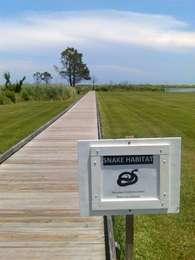Last updated: March 23, 2021
Place
Bodie Island Nature Trail

Historical/Interpretive Information/Exhibits, Parking - Auto, Parking - Boat Trailer, Parking - Bus/RV, Recycling, Restroom - Accessible, Scenic View/Photo Spot, Water - Bottle-Filling Station, Wheelchair Accessible
An eighth-mile long boardwalk leads out through a marsh to a freshwater pond. Along the way, and at the observation deck at the end of the boardwalk, smell the freshness of the marsh and listen to the wildlife around you. Birds migrating along the Atlantic Flyway make use of the freshwater ponds, providing a chance to spot different birds throughout the year. The pond and surrounding wetlands are also home to a diverse range of species, including blue crabs and snapping turtles!
Parking is available at the start of the trail in the parking lot north of the Bodie Island Visitor Center. Also at the start of the boardwalk are restrooms, a drinking fountain with a pet fountain and water bottle filling station, a trash and recycling station, and a bike rack. The observation deck at the end of the trail has three benches and spectacular views of the Bodie Island Lighthouse and surrounding ecosystems.
Atlantic Flyway
Migrating birds move from one location where they breed and raise young in the summer months to another location where they overwinter. Across North America there are four major flyways (paths that migrating birds follow) with one of those four being the Atlantic Flyway.
The Atlantic Flyway is the eastern-most of these four flyways, and is roughly bounded by the Atlantic Coast of North America on the eastern side and the Appalachian Mountains on the western side. The Atlantic Flyway terminates in the north at the eastern Arctic islands and Greenland, and in the south in the Gulf of Mexico region. This area provides a relatively flat land surface to fly over with a variety of species-rich ecosystems to utilize along the way.
Different migratory birds travel through here at different times of the year, making Cape Hatteras National Seashore a wonderful place to observe birds throughout the year.
Phragmites
Phragmites australis is an exotic plant species that is currently threatening the salt and brackish marsh ecosystems of Cape Hatteras National Seashore, ecosystems which heavily contribute to estuarine productivity. This exotic plant species is a significant resource concern because it is able to outcompete native vegetation and is not utilized by the native wildlife. Phragmites australis typically grows in brackish and alkaline wetlands, and tends to inhabit the marsh-upland interfaces where it grows in continuous dense stands. You can see examples of this exotic plant species along the boardwalk.
